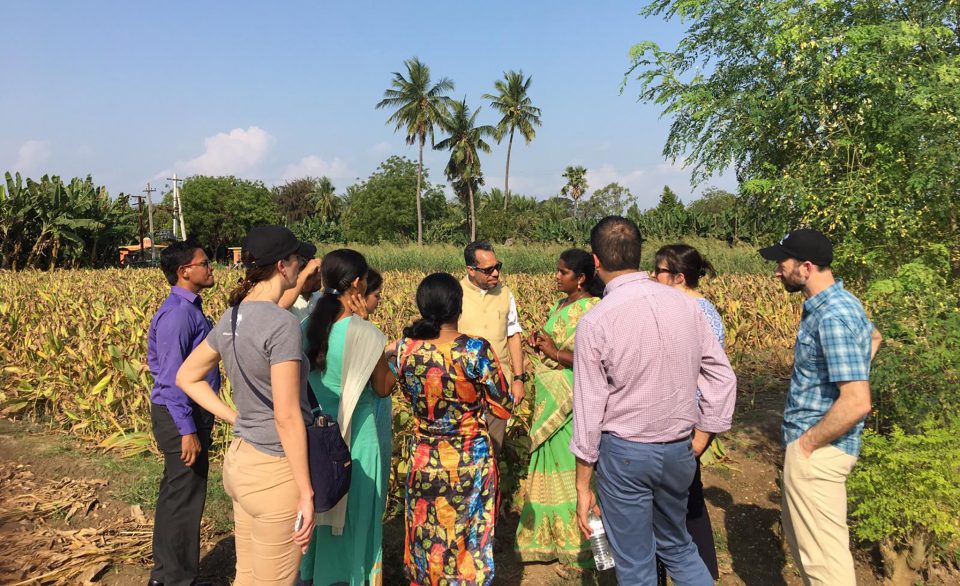Natural farming could help India meet climate goals

A farm owner, who is using Zero Budget Natural Farming (ZBNF) with great success, gives a tour of her property and explains the processes she uses to produce crops.
Its promise sounds incredible: A new farming method that can cut costs, increase yields, and help India meet its Paris Agreement climate goals. This spring, Woodwell Climate Research Center (formerly Woods Hole Research Center) staff joined several partners on a trip to India for a first-hand look at Zero Budget Natural Farming (ZBNF) and to learn more about how Woodwell Climate Research Center can help measure India’s progress towards meeting its Paris targets.
Visiting a country that’s trying to manage both rapid growth and climate challenges, Woodwell scientist Jonathan Sanderman and Vice President Alison Smart traveled to the Indian state of Andhra Pradesh with colleagues from Tufts University’s Fletcher School of Law and Diplomacy and the Council on Energy, Environment and Water (CEEW), one of South Asia’s leading not-for-profit policy research institutions.
India’s federal and state governments have set Paris goals that will push to transform not only energy sources but land use:
- Reduce emissions intensity of its GDP by 33 to 35 percent by 2030 from 2005 level.
- Achieve about 40 percent cumulative electric power installed capacity from non-fossil fuel based energy resources by 2030.
- Create an additional carbon sink of 2.5 to 3 billion tons of CO2 equivalent through additional forest and tree cover by 2030.
“When you hear politicians say that we can’t act before China and India do, they’re ignoring the reality that they’re among the 179 countries that have already ratified the Paris agreement. Not only have they ratified it, they are implementing it through new policies and programs such as ZBNF,” said Kelly Sims Gallagher, Director of the Climate Policy Lab at the Center for International Environment and Resource Policy at The Fletcher School and a former senior policy advisor in the Obama administration.
“With our ongoing partnership with the Fletcher School, we can offer a very comprehensive package of expertise and support. We were eager to learn what’s already happening in India, meet the people doing the work, and find out where they need help expanding capacity,” Smart said.
India’s climate pollution is a long-term concern, but right now local air pollution is a high priority for politicians and the public. The World Health Organization’s 14 most polluted cities last year were all located in India. Coal-fired power plants and transportation contribute to the problem, but a big portion of the pollution is due to agriculture when farmers burn rice stubble after harvest, according to Sanderman. This presents an opportunity to address air pollution, economic development, food security and climate by focusing on good policy and practices in agriculture.
“[Woodwell Climate Research Center] brings a wide set of tools that can look at farming, forests, and other land uses in an integrated fashion. We’re interested in helping make state-level assessments of energy infrastructure needs and land sector planning to find out what’s needed and achievable to help India meet its climate goals,” Sanderman said.
An estimated 61.5 percent of India’s 1.3 billion people live in rural areas and are dependent on agriculture, according to its 2011 census. Today’s conventional farming practices push farmers to rely heavily on industrially-produced fertilizers and pesticides. These pollute water and local ecosystems, kill off biodiversity, and hurt the soil’s long-term natural fertility.
Some Indian farmers have started the ZBNF movement hoping to make farming not just more sustainable environmentally, but financially as well. Expensive seeds, fertilizers and pesticides can make it difficult for small farmers to turn profits, sometimes even trapping them in a perpetual cycle of debt.
“We met with a farmer who’s used ZBNF and has seen her income significantly increase. She’s opened a shop where she sells farm-grown products. We’re interested in finding out if that approach can also help reduce emissions in India,” Smart said.
Under ZBNF, farmers replace purchased products with recycled farm by-products. Dung can be used to give seeds a protective coating and fertilize the soil. Compost can both enrich the soil and retain moisture. And natural pesticides include concoctions made with cow waste, lilac, and green chilies.
“Adopting Zero Budget Natural Farming holds the potential to reinvigorate rural economies, reduce credit risks for farmers, and help agricultural families to allocate greater resources for education, health, and financial security. Andhra Pradesh’s ZBNF experiment could become a role model for low-carbon and climate resilient agriculture, generating livelihood opportunities while safeguarding our natural ecosystems,” said Dr. Arunabha Ghosh, CEO of CEEW.
Since 2015, ZBNF has been rolled out to 523,000 farmers across all 13 districts (3,015 villages) of Andhra Pradesh, bringing almost 504,000 acres of agricultural land under the ZBNF model of agriculture, according to CEEW. ZBNF practices are also supporting biodiversity conservation and regenerating ecosystem services. There is an observable increase in the numbers of birds, reptiles, bees and other wild animals that are finding habitats on the farms. With ZBNF improving soil fertility and strength, farmers have also reported a reduction in their yield loss during droughts.
“India provides a huge opportunity to implement sustainable practices on a large scale. Indian states have populations comparable to European countries. If ZBNF and similar practices work on a large scale in India, it can be a model for other countries looking to sustainably grow their economies,” Sanderman said.







